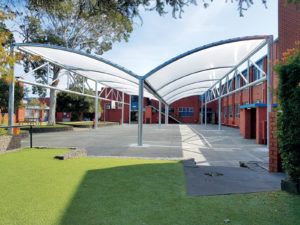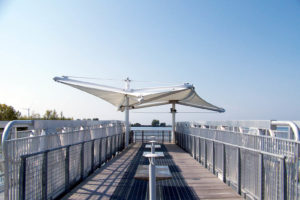
Like other rust belt cities, Detroit began declining decades ago, propelled by a combination of bad luck, bad timing, bad decisions and economic transformations that delivered additional crushing, seemingly fatal, blows. Its condition was such that not so long ago, numerous companies sprang up offering tours of the city’s ruined buildings and factories—a somewhat morbid undertaking, but one
that apparently has had a lot of takers.
There may eventually be less to gawk at. Detroit’s urban areas are undergoing a revitalization, and in this effort, it’s not alone. As Brian Dentinger, director of quality for Birdair Inc., explains, there is growing interest in the redevelopment and rebirth of cities like Detroit. The company, headquartered in Amherst, N.Y., is a specialty contractor for tensile architecture, working with architects, engineers, contractors, owners, developers and others throughout the world. Birdair offers a variety of modular systems designed to meet local wind and snow load requirements, architectural umbrellas (that can be closed) and Quasar structures.
Bringing community to life
“We’re seeing projects along waterfronts and parks in old industrial areas in small towns to large cities. There’s more money and funding available to cities for urban renewal. We see this in New York City, Detroit, Buffalo, Dallas, even smaller cities like Jamestown,” says Dentinger, adding that he can’t recall doing these kinds of projects five or 10 years ago. Birdair now participates in a handful of revitalization efforts annually that incorporate fabric structures.

Recent projects have included tensile shade structures erected at the Buffalo, N.Y., Harbor State Park and Tifft Street Pier, located in the Outer Harbor. Both incorporated the company’s Quasar structures and utilized Teflon®-coated fiberglass.
“It was important to use a material that could stand up to the harsh weather at the west end of Lake Erie. High winds, heavy, wet snow and ice buildup are to be expected annually,” he says, adding that Birdair also uses PVC-coated fabrics when applicable.
Urban renewal projects are undertaken with a variety of objectives in mind: to attract businesses and visitors to old, unused industrial areas or decaying downtown districts; to create parks and gathering places for a city’s inhabitants; to give children safer places to play; and to revive interest and excitement in neglected spaces, among others.
A typical scenario for FabriTec Structures is where the “complete overhaul” of a neighborhood or district is planned, says Claude Centner, executive vice president for the Dallas builder of tensile membrane structures. The company works in various market sectors such as transportation hubs, sports facilities, stadiums and amphitheaters that often require large installations, as well as on smaller projects like entryways and covered walkways.
“I think one of the big goals of urban renewal is to reinvigorate an area’s sense of community,” says Centner. “As neighborhoods age and become blighted, the bonds binding them together weaken. People become isolated. For urban renewal projects to be successful, they need to get people out and involved again in their community.”
Contemporary comfort

Textiles and fabric structures are being utilized in a variety of urban renewal efforts. The role they play depends on the vision of the project, says Centner. “Tensile membrane structures are ideally suited for renewal projects with a contemporary design,” he explains. “For those planned around a historic design aesthetic, tensile membrane structures don’t fit the vision as well.”
According to Centner, FabriTec’s structures are often used to provide a focal point within an urban renewal project and are commonly intended for outdoor use. An example, he mentions a project in Playa Vista, Calif., where the company constructed an amphitheater. The project involved a mix of affordable and luxury housing, office and commercial space, open space and recreational amenities, and was positioned next to restored wetlands and a wildlife preserve. The amphitheater has been used for theatrical productions, outdoor movies and concerts, says Centner, adding that it has become “an iconic fixture of the Playa Vista renewal project.”
Many renewal projects involve providing shade—a feature in growing demand, says Brydon Roe, president and CEO of TensArch Fabric Structures, a manufacturer of custom tensioned fabric structures providing architectural shade and all-weather options for public parks, schools, playgrounds, amphitheaters, skate parks and other outdoor areas. The company is headquartered in Revelstoke, B.C., Canada.
“Urban renewal often seems to incorporate shade, which is good for fabric architecture because this is generally the less expensive option,” he says. “Urban renewal usually means outdoor spaces, and the sun has become unbearable without shade. Even those climates that drop well below zero in the winter experience extreme heat and UV in the summer.”
Roe says his company uses a lot of commercial-grade shade cloth and all-weather fabrics designed to withstand harsh environments and provide extreme UV resistance and fabric strength. “This is paramount for resistance in high winds and in some cases snow loads,” he says. TensArch products include Hypar shade kits, shade structures, cyclone umbrellas, shade sails and the company’s Shade Art artistic line of shades. The company conducts most of its research and development in Australia because of that country’s hot, sunny climate, an effort that has accelerated their learning curve and led to product innovations, says Roe.
Benefits go beyond just shade, especially with schools and sports facilities. “Covered sports arenas at schools can allow practice and competition in all weathers while providing UV protection to the students,” says Toshi Kitada, sales manager for Hiraoka & Co. Ltd. “They can encourage outdoor learning activities. By utilizing fabrics with high light transmission, you can create a wonderful ambiance and still allow natural light into adjoining classrooms.”
Located in Tokyo, Japan, the company manufactures architectural membrane fabrics that provide shelter in a variety of configurations, such as graceful tensile structures, protective and decorative awnings and air-inflated dome structures. The company works directly with architects and engineers, in some cases providing bespoke fabrics or colors when necessary for design integrity. For example, a shopping center project in Queensland, Australia, incorporated entry canopies designed to represent the sand dunes
at a nearby beach.
“The architect required two shades of yellow to mimic the play of light on the sand dunes,” Kitada recalls. “Small samples of the two colors were prepared in our laboratory and supplied to the client for approval prior to production of a special run of these colors.”
Fabric activation solutions
Fabric components can also soften the appearance of an area, Kitada says, serving to draw attention away from hard surfaces like steel and concrete. They also provide a focal point in and of themselves that draw people to an area, an increasingly important consideration.
“Instagram-friendly activations and renovations have become a need rather than a ‘nice to have,’” says Alexis Rochas, CEO and founder of Stereobot Inc. “Cities are beginning to understand the power of short- and medium-term activation in public spaces and they’re more open to fabric as a solution, accounting for a high-impact visual presence.”
Stereobot, headquartered in Los Angeles, is a design and build company composed of architects, designers, engineers and visual artists. Projects have run the gamut from an intimate museum exhibit for the L.A. Museum of Contemporary Art to “massive sculptural place-making structures” for music and art events like Coachella, Rochas says. Urban renewal projects include “The Loop” in Long Beach, Calif., and LuminoCITY, a recent collaboration with the city of Detroit.
For the Long Beach project, the company provided workers and visitors with a place to relax, socialize and enjoy the outdoors in the city’s downtown area. The installation was fashioned to allow for a variety of activities and programming options such as receptions, fitness classes and musical performances.
The Loop structure was a response to a public request for proposals from the Downtown Long Beach Alliance for the design and construction of a temporary outdoor public space on a 7,700-square-foot site, says Rochas. Fabrics were dye-sublimated using solvent-free inks. Stereobot uses a variety of fabrics ranging from vinyl to polyester weaves, with all components 100 percent reusable and recyclable.
For the LuminoCITY project, the company was tasked with “creating a dynamic network of activations revealing Detroit’s historic core,” he says. Consisting of 16 sculptures positioned throughout that area, its objective was to bring together more than 200 storefronts, parks, cultural happenings and local hot spots, linked together by a pedestrian network taking about 20 minutes to traverse.
“These projects are a road map to community building, by dispelling the notion that urban renewal equals large-scale, protracted infrastructural undertakings,” says Rochas. “What happens while large-scale projects gestate can have a profound impact on the development of a community. Underutilized fractions of city fabric can be powerful agents in the health and prosperity of a community.”
Urban requirements
There are many positives that come with urban renewal, but also challenges such as weatherability, wind and snow loads, fire standards and design issues, says James Doherty, architecture sales manager for Verseidag US. Located in Budd Lake, N.J. (Verseidag Indutex is headquartered in Krefeld, Germany), the company manufactures technical textiles for markets such as architecture (membrane and facade), tents, truck tarpaulins, printable marketing applications and interior window treatments, among others.
“Of course, as with any project, cost is also a factor,” Doherty says. “Much of this is determined by the form or shape of the finished design, as this determines the load the material will be receiving; the higher the load, the stronger the material must be. It’s important to understand how the design affects the material and the cost of the project.”
Architectural mesh fabrics—such as polytetrafluoroethylene (PTFE) and polyvinyl chloride (PVC)—are used in a large portion of the company’s facade projects. The fabrics impart a modern look to buildings and parking garages, providing privacy and lowering energy costs by “absorbing and deflecting UV rays,” Doherty says. They’re also recommended for use in outdoor areas where shade is the objective, combining an architectural look with long-term functionality.
Verseidag also offers PTFE and PVC membranes for tensile structures. In urban renewal, they are often used in revitalizing sports arenas and outdoor music venues, providing roof structures and shade. “These venues can then be used for concerts, plays and other entertainment in a year-round, controlled environment for years to come, while maintaining a piece of the historical property,” Doherty says.
Roe agrees that budgets can serve as a deterrent for urban renewal projects, but he doesn’t see this remaining a long-term issue, believing those tasked with urban renewal will “come around in time,” particularly where providing shade is one of the objectives.
“Shade is a necessity and becoming more and more a requirement,” he explains. “It’s a legitimate health risk that cannot be ignored. Municipalities, schools, parks, etc., must protect users and will have to begin to budget for shade. It’s amazing to see how often shade is thought of only after kids can’t use the expensive metal slides that were installed because there was no protection from the sun.”
Pamela Mills-Senn is a freelance writer based in Long Beach, Calif.
 TEXTILES.ORG
TEXTILES.ORG


